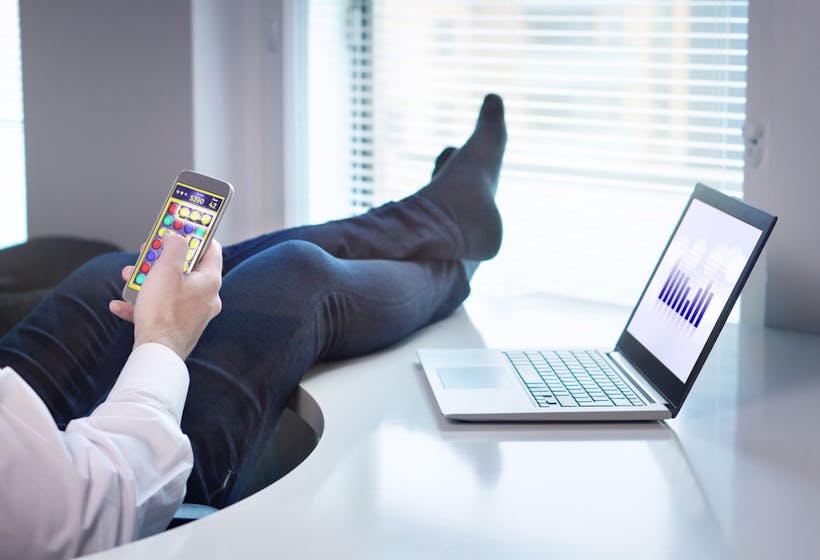
The average employee is productive for less than 3 hours a day. How can companies counteract this?
When we look at the research around how productive employees actually are, the figures are pretty surprising. According to one source, the average employee is productive for only three hours a day. In Britain, we are working longer and longer hours, but seeing no visible gain in productivity. In fact, it has been shown that a third of British employees are distracted for up to three hours a day, with 10% of employees admitting to being productive for only thirty minutes each day.
We distract ourselves in a number of ways, including social media, making hot drinks, reading news sites, chatting to colleagues and even looking for new jobs! This should be a serious performance management concern for any HR department that is seeking to improve overall company performance. But in what ways can we adapt our given processes, inspire employees and raise productivity levels in line with our own expectations?
Allow for flexible working
Businesses are becoming increasingly aware of the benefits of flexible working. It’s been shown to improve productivity levels and boost morale. This is because it simply isn’t realistic to set rigid rules and expect all employees to work in the same way. When we make room for flexibility, in the form of telecommuting, flexi-time or job sharing, we give employees the freedom to work when they feel inspired, motivated and productive.
Encourage employees to take lunch breaks away from their desk
One issue that seriously impairs productivity levels is that of eating lunch at desks. One-third of employees eat lunch at their desks, during which time they reply to emails or answer work calls. At first sight, this might appear to be the behaviour of a dedicated and engaged employee, but we have legally mandated break requirements for good reason. The human brain needs to recharge. Food fuels your brain and taking short, frequent breaks give employees more stamina. Further, employees who spend their lunch breaks away from their desks are 10% more productive and 12% less likely to make errors.
So if you have a work culture that awards employees who slave away during their lunch breaks, you should rethink your approach.
Encourage employees to take their annual leave
A third of Britons don’t take their full annual leave allowance. Employees refrain from going on holiday because they feel intimidated by their workload, what they might have to deal with when they get back and the impression it will make on their manager. As with a good lunch break, though, a vacation has the power to revitalise and inspire great performance. As one source points out, when we deprive ourselves of holidays, we make more mistakes and we develop a resentment for our co-workers. Employees who take holidays gain a better perspective and are more motivated to achieve their goals, and such benefits can even be seen from a break as short as 24 hours.
You don’t want your employees to burn out. HR should be tracking how much annual leave has been spent and ensuring those who are due a break actually take time off, for the benefit of employee health, wellbeing and performance.
Revitalise your goal setting process
If your employees aren’t productive, it may be a result of diminished enthusiasm and passion for their work. Consider how much input an employee actually has with regards to their objectives. Do they even understand them? Do the objectives excite them, are they challenging enough, or are they unrealistic? Take all of these questions into consideration, and decide whether or not your goal setting process requires a drastic overhaul.
To get employees involved, managers should collaborate with them on setting SMART objectives, while giving employees a large say in what their short-and-long-term goals actually are. This will give them ownership over their goals, therefore making them more inclined to achieve them, and ultimately boosting employee productivity.
Use performance review software to track goal progress
Setting goals is one thing, but tracking them is something altogether different. In order to determine whether or not your employees are truly being productive, line managers, HR and the employees themselves need to be able to track ongoing progress. This is possible with the advancement of modern technology. Specifically, Clear Review’s performance review software uses cloud-based technology that allows everyone involved to track and update objectives throughout a given business year. If an employee is failing to progress at a satisfactory rate, managers can step in and offer help as required.
Get employee feedback on what might be impeding their productivity
These days, all businesses should be considering a transition from old-fashioned annual appraisals to continuous performance management. This form of performance management makes use of regular monthly check-ins, which improve communication and trust levels between employee and manager. During this time, managers should solicit feedback from underperforming employees to determine whether there is an existing workplace process or problem that is impeding productivity. If this is the case, steps can be put in place to resolve the problem. Always make it clear that management is eager and willing to take feedback on board, and their problems will be listened to.
To find out how Clear Review performance management software can help catapult company-wide productivity and performance, book a free 15-minute performance management consultation. Our expert team is eager to help.
